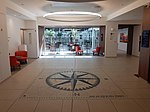Istituto Statale Italiano Leonardo Da Vinci
France–Italy relationsInternational schools in ParisItalian international schools in Europe

The Istituto Statale Italiano Leonardo Da Vinci (French: Lycée italien Leonardo da Vinci) is an Italian government-owned Italian international school in Paris, France. Its scuola media and liceo scientifico (junior and senior high school, or high school and sixth-form college), along with the school administration, occupies one campus in the 7th arrondissement. The elementary school is housed in a different campus in the same arrondissement.The Lycée français Chateaubriand, the French school of Rome, is considered to be its sister school. This was established by the Convention Culturelle italo francese of November 4, 1949.
Excerpt from the Wikipedia article Istituto Statale Italiano Leonardo Da Vinci (License: CC BY-SA 3.0, Authors, Images).Istituto Statale Italiano Leonardo Da Vinci
Rue Sédillot, Paris 7th Arrondissement (Paris)
Geographical coordinates (GPS) Address Website External links Nearby Places Show on map
Geographical coordinates (GPS)
| Latitude | Longitude |
|---|---|
| N 48.8586 ° | E 2.3015 ° |
Address
Lycée étranger privé Léonard de Vinci
Rue Sédillot 12
75007 Paris, 7th Arrondissement (Paris)
Ile-de-France, France
Open on Google Maps










